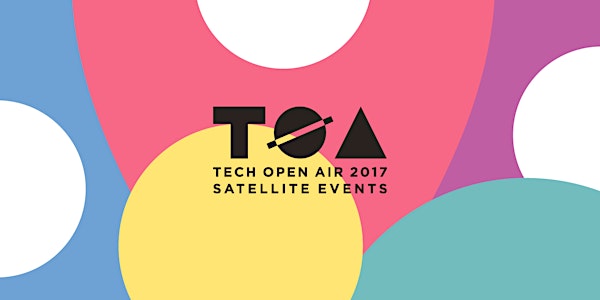Using IoT to Create Art | Using Art to Envision IoT
Adaptation is an interactive art installation for which 7 artists, paired with tech companies, have created work about the Internet of Things (IoT), its possibilities and how it will impact our future. This event is part of the Research and Innovation project AGILE, funded by the European Commission under the H2020 initiative.
Working in four different categories, Quantified-Self, Interactive Spaces, Smart Cities and Environment + Data, which reflect important tendencies within IoT, artists have created installations which will allow the public to see and interact with data obtained from the environment, the spectators themselves or from the internet.
Schedule:
Opening: 11th July 6pm-10pm
Exhibition: 12th-13th July, 11am-8pm
The exhibition will be held in CRCLR, an experimental center for sustainable and artistic practices in the heart of Neukölln.
The first project titled E-CAMERA by Hamburg based artists Luiza Fabrizi and Andre Landwehr working in the category of Quantified Self, is a camera which reads emotion-related bio-signals from the user's’ body and uses this data to modify the image. The result being an image which reflects the momentary embodied emotional reality of the person taking the photograph.
The second, STILL TOUCHABLE? for the Interactive Spaces category is a collaboration between anthropologist and artist Yeon Sue Park and data researcher Souneil Park. The project invites us to reexamine our relationship to media and its tangibility through the creation of an intangible data center which can only be explored through our special relationship to it.
The third is a project by French-British artist Thomas Grogan, his FLORAL AUTOMATON, as part of the Smart Cities category, is a sculptural piece that grows digital plants in response to environmental data gathered in real-time from the sculpture’s location.
Finally in the Environment + Data Category the project FOUNTAINS by artist and technologist Justus Harris and mathematician and civic hacker Eric Dolores, takes information regarding water pollution from around the world and transforms 3D scanned models of people to reflect the quality of their local water sources.
As a collaboration between the AGILE research project and the Architectural Association Greece Visiting School, one fifth installation will be exhibited at Adaptation: IVI. Made of 45 square meters of kite fabric held together by 400 meters of fiber, IVI is the and the end-result of the architectural program focused on making use of advanced methodologies for architectural design, interactive spacial systems and digital methods for fabrication through a series of parametric morphologies and manipulation of space.
What all of these installations hold in common is the use of the AGILE IoT gateway, the center piece of the AGILE research project and the result of the previous 18 months of hard work and collaboration between 16 partners across the UE. (http://agile-iot.eu).
Adaptation is an interactive art installation for which 7 artists, paired with tech companies, have created work about the Internet of Things (IoT), its possibilities and how it will impact our future. This event is part of the Research and Innovation project AGILE, funded by the European Commission under the H2020 initiative.
Working in four different categories, Quantified-Self, Interactive Spaces, Smart Cities and Environment + Data, which reflect important tendencies within IoT, artists have created installations which will allow the public to see and interact with data obtained from the environment, the spectators themselves or from the internet.
Schedule:
Opening: 11th July 6pm-10pm
Exhibition: 12th-13th July, 11am-8pm
The exhibition will be held in CRCLR, an experimental center for sustainable and artistic practices in the heart of Neukölln.
The first project titled E-CAMERA by Hamburg based artists Luiza Fabrizi and Andre Landwehr working in the category of Quantified Self, is a camera which reads emotion-related bio-signals from the user's’ body and uses this data to modify the image. The result being an image which reflects the momentary embodied emotional reality of the person taking the photograph.
The second, STILL TOUCHABLE? for the Interactive Spaces category is a collaboration between anthropologist and artist Yeon Sue Park and data researcher Souneil Park. The project invites us to reexamine our relationship to media and its tangibility through the creation of an intangible data center which can only be explored through our special relationship to it.
The third is a project by French-British artist Thomas Grogan, his FLORAL AUTOMATON, as part of the Smart Cities category, is a sculptural piece that grows digital plants in response to environmental data gathered in real-time from the sculpture’s location.
Finally in the Environment + Data Category the project FOUNTAINS by artist and technologist Justus Harris and mathematician and civic hacker Eric Dolores, takes information regarding water pollution from around the world and transforms 3D scanned models of people to reflect the quality of their local water sources.
As a collaboration between the AGILE research project and the Architectural Association Greece Visiting School, one fifth installation will be exhibited at Adaptation: IVI. Made of 45 square meters of kite fabric held together by 400 meters of fiber, IVI is the and the end-result of the architectural program focused on making use of advanced methodologies for architectural design, interactive spacial systems and digital methods for fabrication through a series of parametric morphologies and manipulation of space.
What all of these installations hold in common is the use of the AGILE IoT gateway, the center piece of the AGILE research project and the result of the previous 18 months of hard work and collaboration between 16 partners across the UE. (http://agile-iot.eu).
